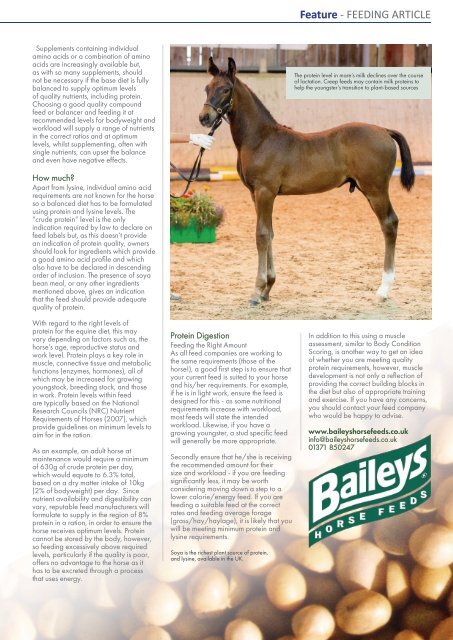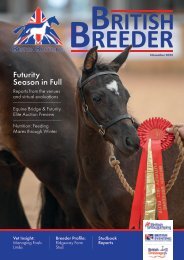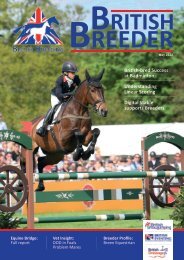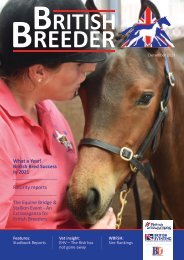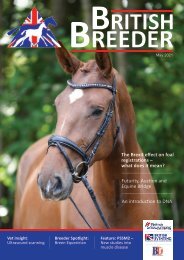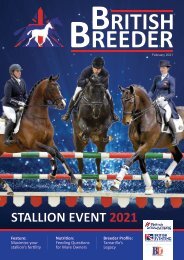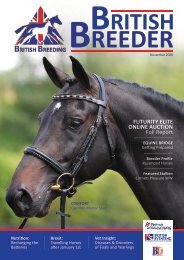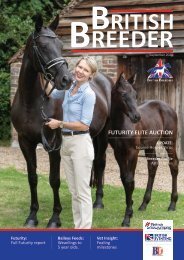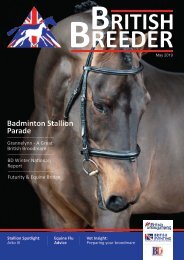British Breeder Magazine May 2020
Magazine for breeders of British bred sport horses. Includes breeding industry news, updates, interviews, profiles and reports.
Magazine for breeders of British bred sport horses. Includes breeding industry news, updates, interviews, profiles and reports.
You also want an ePaper? Increase the reach of your titles
YUMPU automatically turns print PDFs into web optimized ePapers that Google loves.
Feature - FEEDING ARTICLE<br />
Supplements containing individual<br />
amino acids or a combination of amino<br />
acids are increasingly available but,<br />
as with so many supplements, should<br />
not be necessary if the base diet is fully<br />
balanced to supply optimum levels<br />
of quality nutrients, including protein.<br />
Choosing a good quality compound<br />
feed or balancer and feeding it at<br />
recommended levels for bodyweight and<br />
workload will supply a range of nutrients<br />
in the correct ratios and at optimum<br />
levels, whilst supplementing, often with<br />
single nutrients, can upset the balance<br />
and even have negative effects.<br />
The protein level in mare’s milk declines over the course<br />
of lactation. Creep feeds may contain milk proteins to<br />
help the youngster’s transition to plant-based sources<br />
How much?<br />
Apart from lysine, individual amino acid<br />
requirements are not known for the horse<br />
so a balanced diet has to be formulated<br />
using protein and lysine levels. The<br />
“crude protein” level is the only<br />
indication required by law to declare on<br />
feed labels but, as this doesn’t provide<br />
an indication of protein quality, owners<br />
should look for ingredients which provide<br />
a good amino acid profile and which<br />
also have to be declared in descending<br />
order of inclusion. The presence of soya<br />
bean meal, or any other ingredients<br />
mentioned above, gives an indication<br />
that the feed should provide adequate<br />
quality of protein.<br />
With regard to the right levels of<br />
protein for the equine diet, this may<br />
vary depending on factors such as, the<br />
horse’s age, reproductive status and<br />
work level. Protein plays a key role in<br />
muscle, connective tissue and metabolic<br />
functions (enzymes, hormones), all of<br />
which may be increased for growing<br />
youngstock, breeding stock, and those<br />
in work. Protein levels within feed<br />
are typically based on the National<br />
Research Councils (NRC) Nutrient<br />
Requirements of Horses (2007), which<br />
provide guidelines on minimum levels to<br />
aim for in the ration.<br />
As an example, an adult horse at<br />
maintenance would require a minimum<br />
of 630g of crude protein per day,<br />
which would equate to 6.3% total,<br />
based on a dry matter intake of 10kg<br />
(2% of bodyweight) per day. Since<br />
nutrient availability and digestibility can<br />
vary, reputable feed manufacturers will<br />
formulate to supply in the region of 8%<br />
protein in a ration, in order to ensure the<br />
horse receives optimum levels. Protein<br />
cannot be stored by the body, however,<br />
so feeding excessively above required<br />
levels, particularly if the quality is poor,<br />
offers no advantage to the horse as it<br />
has to be excreted through a process<br />
that uses energy.<br />
Protein Digestion<br />
Feeding the Right Amount<br />
As all feed companies are working to<br />
the same requirements (those of the<br />
horse!), a good first step is to ensure that<br />
your current feed is suited to your horse<br />
and his/her requirements. For example,<br />
if he is in light work, ensure the feed is<br />
designed for this - as some nutritional<br />
requirements increase with workload,<br />
most feeds will state the intended<br />
workload. Likewise, if you have a<br />
growing youngster, a stud specific feed<br />
will generally be more appropriate.<br />
Secondly ensure that he/she is receiving<br />
the recommended amount for their<br />
size and workload - if you are feeding<br />
significantly less, it may be worth<br />
considering moving down a step to a<br />
lower calorie/energy feed. If you are<br />
feeding a suitable feed at the correct<br />
rates and feeding average forage<br />
(grass/hay/haylage), it is likely that you<br />
will be meeting minimum protein and<br />
lysine requirements.<br />
Soya is the richest plant source of protein,<br />
and lysine, available in the UK.<br />
In addition to this using a muscle<br />
assessment, similar to Body Condition<br />
Scoring, is another way to get an idea<br />
of whether you are meeting quality<br />
protein requirements, however, muscle<br />
development is not only a reflection of<br />
providing the correct building blocks in<br />
the diet but also of appropriate training<br />
and exercise. If you have any concerns,<br />
you should contact your feed company<br />
who would be happy to advise.<br />
www.baileyshorsefeeds.co.uk<br />
info@baileyshorsefeeds.co.uk<br />
01371 850247<br />
BRITISH BREEDER| 55


